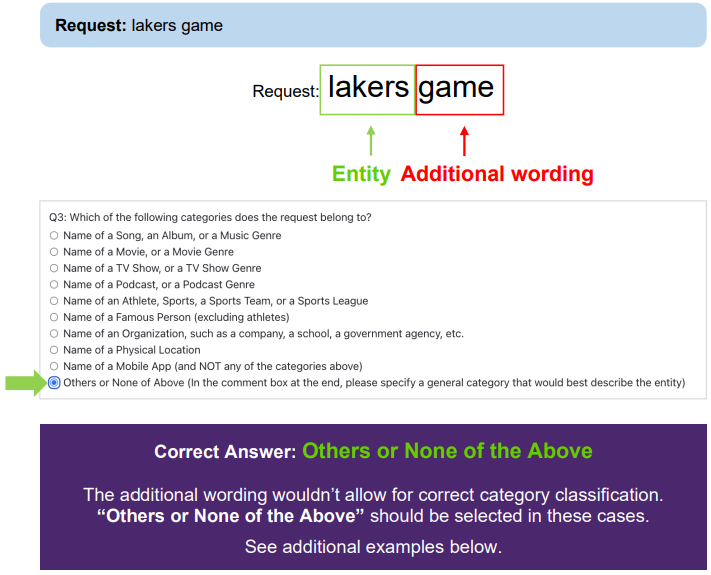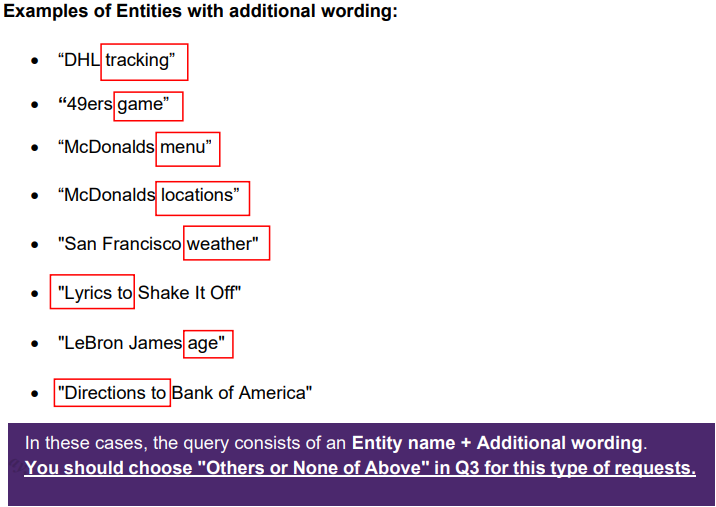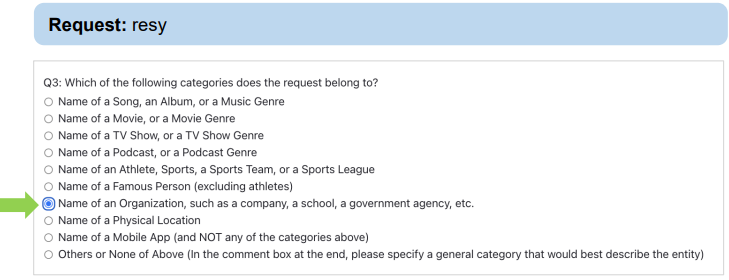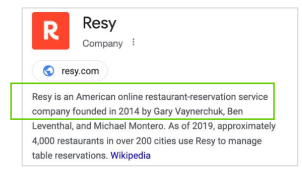Common Mistake #1: Failing to identify additional wording.
The most common mistake in this task is observed in Q3 (Categories).
Guidelines indicate for Q3, to select one of the categories given in the list, or select
“Others or None of the Above” if the entity contains additional wording.
We noticed that the majority of analysts are ignoring this rule, and are incorrectly classifying queries with extra wording as something else.

Examples of requests that consist of ONLY Entity names:
In these cases, the request consists of only an Entity name. In these cases, please choose the category that best describes the user’s request in Q3.
Examples of Entities with additional wording:

You should choose “Others or None of Above” in Q3 for this type of requests.
Common Mistake #2: Apps VS Organizations.
Another common mistake in this task is observed in the same question (Q3 – Categories), when deciding whether a request refers to an ‘App’, or an ‘Organization’.
If a request can be categorized as both, before selecting “Name of a Mobile App”, you should always do research to determine if the request can be first classified as any of the other categories given above in the list. Example:

The Wikipedia page of “Resy” says that “Resy is an American online restaurantreservation service company”, so this request belongs to “organization” category:

“Resy” could also be categorized as a “Mobile App”, however, according to the task instructions, the further-above category “Organization” should be selected in these cases:

Please note: The option for “Mobile App” should only be selected if none of the categories above in the list could be selected.
Common Mistake #3: Can this fit into the category?
We found mistakes related to categories and what should or should not be included in the category.
Request: Rotten Tomatoes
As per research, we can determine that Rotten Tomatoes is: “Rotten Tomatoes is an American review-aggregation website for film and television.“
Even if the website is dedicated to movies/TV shows, it would not belong to the category “Name of a Movie, or a Movie Genre” nor to the category “Name of a TV Show, or a TV Show Genre”
Always conduct proper research to determine if the request fits in the category or if it is just related to that category but would not belong to it.
Common Mistake #4: Can it be considered a physical location?
Request: Northrup Court Apartments
There seems to be confusion regarding requests for physical locations, specifically rentals/apartments. Even if the apartments are private, we would still consider those as physical location. If a user would like to go to the Northrup Court Apartments and put that name on a mapping tool, the results would be a physical location as a destination.
Please refrain from putting physical locations in the “Others or None of Above” category. As long as the request is a location, private or public, it would fit in the “Physical location” category.
Common Mistake #5: Can the request be understood?
Another common mistake in this task is also observed in Question 1 (Can the request be understood?), when deciding whether a request can be understood or not.
Q1 should be answered “Yes”, unless it can’t be understood, because of the following reasons:
Please use your best judgement to answer this question, and only select “No” if it’s impossible to understand the query because of the reasons mentioned above.
Common Mistake #5: Clear Intent VS Ambiguous Intent
Lastly, another common mistake observed in these tasks is in Question 2 (Is the user’s intent clear?).
If there are multiple interpretations of the request, please conduct research and use your best judgement to answer Q3, and select the category you consider to be the most appropriate for the request, or “Others or None of the Above” if the category is not listed.
Any reasonable choices of category would be correct, but research should be conducted, and a justification be provided in the comments to support your ratings.